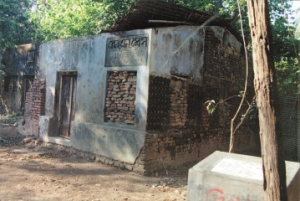| Behind the Scene
From Kushtia
The Legacy of Kangal Harinath
Sikander Ali
Kumarkhali, an old prosperous upazilla town, is about half an hour's bus ride from Kushtia across the Gorai Bridge towards the east. Since olden times it has been a famous trading centre. Old magnificent buildings bear ample testimony to its past glory. The river Gorai flows by gorging on a sizeable portion of the old town and still engulfing the new. Handloom factories, the ancestral trade of the local people, have sprung up here and there. Steady rhythmic sounds of the looms at work keep coming from therein. From Kumarkhali railway station, over the bazaar, a lane leads up to Kundapara. There are cool rows of trees on both sides. At the end of the lane there is “Kangal Kuthir', the ruins of Kangal Harinath's house.
Kangal Harinath (1833- 1896) was one of the few dedicated souls who relentlessly struggled to relieve the sorrows of the people. But his own life was a tale of immeasurable suffering. He combined in himself, with some measure of success, the calling of a literary figure, an editor, a teacher, a reformer and a composer of Baul songs. In 1855 he established the Vernacular School in his own village and taught there for a while. He then took up journalism as a profession. He welded his mighty pen against the oppressions of the predatory Zaminders, usurers, kuthials and local administrators. In doing so, he exposed his own life to danger. Harinath first wrote in a newspaper called “Sangbad Provakar”. However, his greatest contribution was the publication of 'Grambarta Prakashika' (1860), first a monthly, then fortnightly and afterwards a weekly magazine. Although at the beginning it was published from Calcutta, from 1864 Harinath started printing it from his own press in Kumarkhali.
Today, on approaching 'Kangal Kuthir', from a distance an inscription on the wall comes into view which reads: “MN Press, Kangal Kuthir”. Old dilapidated walls stand somehow erected with no roof above. Bricks are coming off the walls. Chunks of cow dung to be dried and later used as solid fuel are seen plastered on the walls.
In a tin-roof house nearby, lives Ashok Majumder's family, the fourth progeny of Kangal Harinath. There is an air of poverty all about. The room at the front is faintly lit. There is hardly any furniture inside. The floor is damp. There are holes on the tin roof above head. Attached to the room is a tiny cabin. Above the door of the cabin hangs a sign board: “Kangal Harinath Pathagar”. Another room, dark and squalid, houses a large portrait and the last remains of Kangal Harinath.
 Ashok Majumder shows a keen interest in the study of Kangal Harinath. He has a good collection of Harinath's hand-written manuscripts, old copies of the 'Grambarta Prakashika' and some rare specimens of writings in his possession. He lays them all on the table. He repeats the need for building a museum and a library to preserve the remnants of Harinath's memory. Ashok Majumder emphatically claims that Kangal Harinath's “Vijoy Bashanta” is the first Bengali novel, in favour of which he also provides evidence. He has painstakingly produced a chronicle of Harinath's life. Kangal Harinath Girls' School established by Harinath himself, not far from his house, is now well established. In the visitor's book many eminent persons have recorded their impressions. Every one is of the view that the last relics of Kangal Harinath must be preserved without farther delay. Ashok Majumder shows a keen interest in the study of Kangal Harinath. He has a good collection of Harinath's hand-written manuscripts, old copies of the 'Grambarta Prakashika' and some rare specimens of writings in his possession. He lays them all on the table. He repeats the need for building a museum and a library to preserve the remnants of Harinath's memory. Ashok Majumder emphatically claims that Kangal Harinath's “Vijoy Bashanta” is the first Bengali novel, in favour of which he also provides evidence. He has painstakingly produced a chronicle of Harinath's life. Kangal Harinath Girls' School established by Harinath himself, not far from his house, is now well established. In the visitor's book many eminent persons have recorded their impressions. Every one is of the view that the last relics of Kangal Harinath must be preserved without farther delay.
But nothing whatsoever has happened so far.
Ashok Majumder's wife turns the key in the lock and opens the shabby door of the Kangal kuthir.
The old MN Press (named after Mothura Nath, the donor of the press) remains abandoned, exposed to rust in rain and the sun. Some boxes containing type cases smeared with dust lie dismantled. Outside Kangal Kuthir, there lies a foundation stone with “Kangal Harinath Smriti Zadughar” inscribed on it. In 1994, on Harinath's one hundred and sixtieth birth-anniversary, two honourable secretaries of the Ministry of Cultural Affairs and the Ministry of Commerce visited this place and laid the foundation stone. Ashok Majumder says that no development work could be carried out because of a high court injunction over the dispute of ownership between him and Ramakanta Majumder, who claims to be an heir of Kangal Harinath. Local people say, Ramakanta's claim is unfair.
When asked if he would like the press to be shifted to a museum, Ashok Majumder asserts, “The museum must be built here. I'll in no way let it go to any other place.”
Copyright
(R) thedailystar.net 2006 |
|
